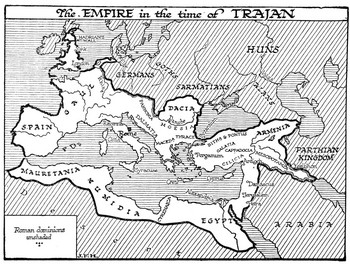An Introduction to Ancient Rome
|
Share This Page
|
|
|
|
|
|
|
Follow This Site

|
 |
|
|
Part
6: Empire's Rise and Fall
A
succession of emperors did both great and terrible things
(often at the same time). Some of the most important
emperors were these:
 Trajan,
who built great structures in and around Rome, including
a huge Forum
and a great wall along the Rhine River, in what is now
Germany;
Trajan,
who built great structures in and around Rome, including
a huge Forum
and a great wall along the Rhine River, in what is now
Germany;- Hadrian,
who built great structures in Rome and elsewhere,
including Hadrian's
Wall, a massive
stone wall that divided Roman
Britain from
Scotland.
- Marcus
Aurelius, who
won great victories over the German tribes and also
became known as a philosopher-king for his famous
writings;
- Constantine,
who became known for introducing tolerance of Christianity tfor moving the capital
of the empire to Constantinople,
in what is now Turkey. (He named this city after
himself.)
 Despite
these successes, the Roman Empire soon grew too large to
control. More and more generals lost more and more territory
to Germanic tribes and other invaders. Rome itself was
sacked by Alaric
and the Visigoths in A.D. 410. The traditional date of the
Fall of the Western Empire is 476, when Odoacer
the Barbarian defeated the Roman legions defending their
capital and installed himself on the throne of the empire.
Despite
these successes, the Roman Empire soon grew too large to
control. More and more generals lost more and more territory
to Germanic tribes and other invaders. Rome itself was
sacked by Alaric
and the Visigoths in A.D. 410. The traditional date of the
Fall of the Western Empire is 476, when Odoacer
the Barbarian defeated the Roman legions defending their
capital and installed himself on the throne of the empire.
(The
Empire had, by this time, been divided into two parts:
Eastern and Western. The Eastern part, with its capital at
Constantinople, survived for hundreds of years after the
"fall" of the Western part. This part of the Empire became
known as the Byzantine Empire.)
Next
page > Construction,
Culture, Economics
> Page 1,
2,
3,
4,
5,
6, 7,
8,
9




 Despite
these successes, the Roman Empire soon grew too large to
control. More and more generals lost more and more territory
to Germanic tribes and other invaders. Rome itself was
sacked by
Despite
these successes, the Roman Empire soon grew too large to
control. More and more generals lost more and more territory
to Germanic tribes and other invaders. Rome itself was
sacked by 
